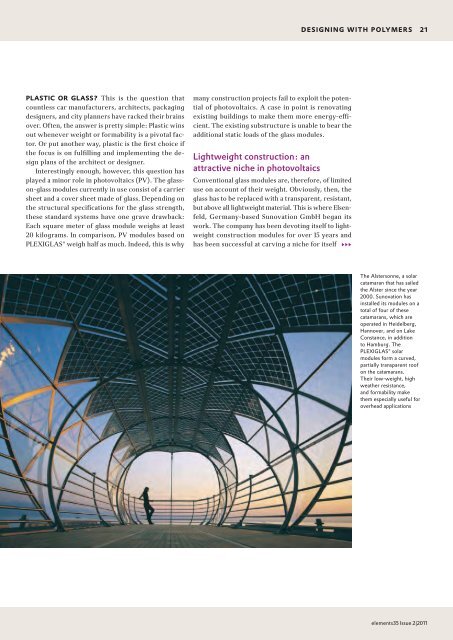Download - Evonik Industries
Download - Evonik Industries
Download - Evonik Industries
You also want an ePaper? Increase the reach of your titles
YUMPU automatically turns print PDFs into web optimized ePapers that Google loves.
PLAstIC oR GLAss? This is the question that<br />
countless car manufacturers, architects, packaging<br />
designers, and city planners have racked their brains<br />
over. Often, the answer is pretty simple: Plastic wins<br />
out whenever weight or formability is a pivotal factor.<br />
Or put another way, plastic is the first choice if<br />
the focus is on fulfilling and implementing the design<br />
plans of the architect or designer.<br />
Interestingly enough, however, this question has<br />
played a minor role in photovoltaics (PV). The glasson-glass<br />
modules currently in use consist of a carrier<br />
sheet and a cover sheet made of glass. Depending on<br />
the structural specifications for the glass strength,<br />
these standard systems have one grave drawback:<br />
Each square meter of glass module weighs at least<br />
20 kilograms. In comparison, PV modules based on<br />
PLEXIGLAS® weigh half as much. Indeed, this is why<br />
many construction projects fail to exploit the potential<br />
of photovoltaics. A case in point is renovating<br />
existing buildings to make them more energy-efficient.<br />
The existing substructure is unable to bear the<br />
additional static loads of the glass modules.<br />
Lightweight construction: an<br />
attractive niche in photovoltaics<br />
Conventional glass modules are, therefore, of limited<br />
use on account of their weight. Obviously, then, the<br />
glass has to be replaced with a transparent, resistant,<br />
but above all lightweight material. This is where Elsenfeld,<br />
Germany-based Sunovation GmbH began its<br />
work. The company has been devoting itself to lightweight<br />
construction modules for over 15 years and<br />
has been successful at carving a niche for itself 333<br />
DesIGnInG WItH PoLYMeRs 21<br />
The Alstersonne, a solar<br />
catamaran that has sailed<br />
the Alster since the year<br />
2000. Sunovation has<br />
installed its modules on a<br />
total of four of these<br />
catamarans, which are<br />
operated in Heidelberg,<br />
Hannover, and on Lake<br />
Constance, in addition<br />
to Hamburg. The<br />
PLEXIGLAS® solar<br />
modules form a curved,<br />
partially transparent roof<br />
on the catamarans.<br />
Their low-weight, high<br />
weather resistance,<br />
and formability make<br />
them especially useful for<br />
overhead applications<br />
elements35 Issue 2|2011
















